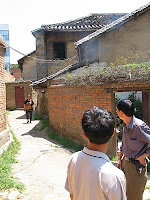Great Earthquakes I Have Known: Quake #4, China, 2004
Friday, April 11, 2008
Zhaotong City, Yunnan, August 10, 2004, 6:26 p.m. (5.6 Richter).
That summer, I taught a three week English class at South West China Normal University, at Beibei, Chongqing. When it ended, I took a vacation into Yunnan with some of my new friends from the university. I asked to put Zhaotong on our itinerary, even though few tourists consider it important. I wanted to see what was left from the work of Samuel “Bó GéLǐ” Pollard (柏格理), a British missionary who lived there from the 1880’s until 1914. I once read an abridged version of his diary, and was deeply impressed. In the afternoon, local officials took us to see Pollard’s legacy.
The school that started in his home had grown into a very large and modern-looking institution.
The forty-bed hospital was sparsely equipped but professional looking. (No doubt, by that evening, it was full.)
The church displayed the distinctive beauty of its heavily Miao (Hmong) membership. My English-speaking Miao tour guide was a student at the seminary. Both the church and the seminary operate under the “Three Self” government authority.
The one building I was not allowed to go into was the crumbling two story building where Pollard ministered (downstairs) and had his bedroom and office (upstairs). In Pollard’s day, construction was done with mud bricks, and it was so old the officials were worried about it falling down.
Later, we drove outside the city to the compound of Long Yun (龙云, 1884-1962), the warlord/governor who ruled Yunnan from 1927-1948. This had once been a very elegant estate, with dozens of beautiful buildings. These also had been constructed of mud bricks, but their thick walls had been surfaced with fine tiles. The buildings were falling apart and had been abandoned, but were still very pleasant to view.
I even found some spiders to photograph.

The Chinese have investigated the possibility that animal behavior changes just before an earthquake and can be used for predictive purposes. If this spider was trying to tell me something, I missed it.
We enjoyed visiting with the crowd of local people who took an interest in us.
Then we returned to town in our taxi.
Sometime during that trip, the earthquake hit. It killed four people, injured another 594, collapsed 6,185 houses and damaged 21,867, leaving 126,000 people homeless. Yet riding in the taxi, we never felt anything.
We only realized there had been an earthquake when we arrived back at our hotel. Dozens of people came running out of the tall building to escape one of the aftershocks. Later, we went to an internet café. While sending emails to say I was okay, I was aware of several aftershocks. I never actually saw any damage and only realized the severity of the quake after we had moved on. We had to be on the train at 4:00 the next morning, so I have no idea how Pollard’s original building or Long Yun’s fared in the quake. I may have been among the last people to see some of these historic relics standing.
So from this quake, the seismological lesson is that whether the spiders warn you of the coming quake, or not, take a taxi if you possibly can.
1 comments:
Anonymous
said...
April 24, 2009 at 6:11 AM
Subscribe to:
Post Comments (Atom)













Hi Brian, thanks for your visit and kind remarks to my photo blogs. I'm currently living in China, so for some reason I couldn't open up my own blogs here and won't be able to approve your comments for a while. As you probably know, I did go to Shimenkan via Zhaotong in late 2006. When we rested in that city I had visited the old church that was established by Sam Pollard. The old building you mentioned in your blog where he used to live in was still there and occupied, so I couldn't enter it, either. I wasn't aware of the modern hospital built on the remains of the old one but I did visit the church itself. A female pastor showed me around and as you know, she's "three self" so we didn't talk much.
The film project is now in the marketing and fundraising stage and yet goes into the production. However, the film centers on the life of a Hmong Christian pastor rather than Pollard himself, though his legacy is clearly seen throughout the story. --- Robert Lin